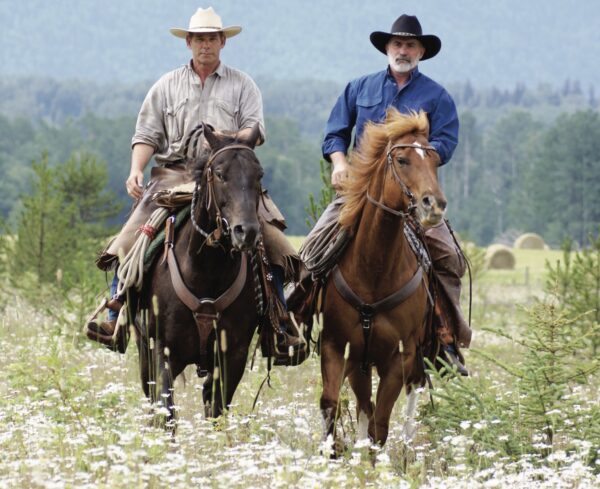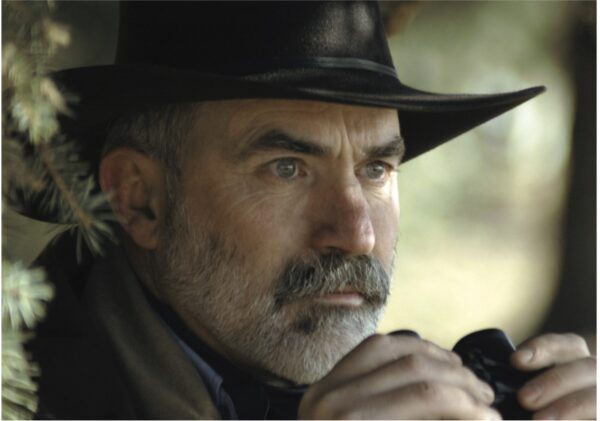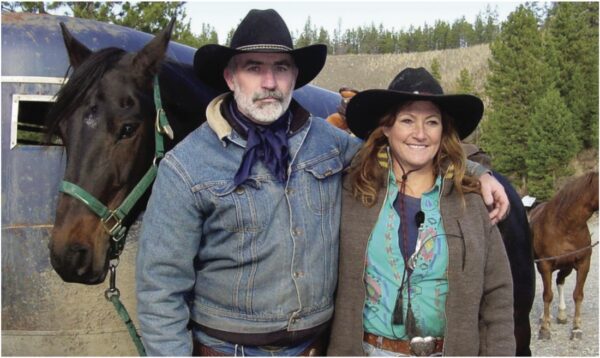The ultimate reality show ~ Cowboy Style By Terri Mason
Originally Published February/March 2009 Canadian Cowboy Country Magazine
The premise of the popular Canadian reality series, Mantracker, is simple; two people take off into the wilds with a map, a compass and a head start. The tracker is on horseback, armed with a local guide and an arsenal of forensic skills. The prey has 36 hours to reach a finish line some 40 km away, in any way they can, without getting caught.
It’s not about rules; it’s not about money. The prey is looking for glory. Mantracker is looking for them.

Now entering its fourth season, Mantracker has fired the imagination of viewers who pit themselves against time, terrain, weather and a veteran tracker. Sometimes their self-assessment is right on and they win; more often than not, they’re caught woefully short of the finish line, filthy and exhausted from the overtly physical and deeply psycho- logical chase.
Mantracker is Terry Grant, a savvy working cowboy from southern Alberta with a lifetime of bush experience and professional tracking skills learned and honed in the real life and death world of Alberta’s Search and Rescue (SAR).
Grant and the crew have just wrapped shooting in a season that took them to B.C., Saskatchewan, Ontario, Newfoundland and across the Medicine Line into California. There’s not too many places they haven’t shot, including the Yukon, Nova Scotia and Quebec. Almost all of the provinces — and the U.S. — recognize the win-win of the international coverage of their province’s incredible beauty and bend over backwards to help with production’s steep costs of hotels and transportation; all of them except, ironically, Alberta and B.C.
“We’ve only shot two episodes here. I’d love to shoot close to home, but what can you do?” Grant mused.

It’s a long way from the wind- swept southern ranges of Alberta to being the ultimate man’s-man, and it was a twist of fate that won him the role. The Toronto producers had the go-ahead on the show, so the hunt was on for a star that was bona fide; a man who was a straight talker; a man who could ride, track — and look good doing it. They heard about Grant and flew out to Alberta.
“Write down they hired me for my looks,” Grant asserts with a big laugh. “The fact that I could ride and track was a bonus.”
The logistics of the show is also bona fide; the production team scouts the locations and chase supervisor, Lawrence Foster, designs the course, creates the maps for the prey and even gives them last- minute tips. The prey only meets Grant if he captures them, or after the show has finished taping. There is no prior contact.
The day before filming starts, Grant, who mentally transforms into Mantracker, is introduced to his guide and his horse. Mantracker and his guide (or side- kick as he’s called in the show) has no prior knowledge of the course. All he knows is that somewhere within 30 or 40 kilometres is the finish line. A flare is fired from the starting point and explodes in the sky. The hunt is on.
“Right up until the flare goes off,” explained Grant, “I don’t even know what direction the finish line is.”
The flare signals the prey to start running. Mantracker has to ride to the starting point and comb the area for sign to determine which direction they’ve headed. That’s where the sidekick comes in. “He knows most of the trails,” explained Grant. “A lot of times when the flare goes off, I depend on him to get me to the flare site, after that, 90 per cent is me having to track them.”
When the prey runs into the bush, or they take a shortcut and are spotted by Mantracker, “It’s up to my sidekick to give me a heads up on where they’re going to come out and which way we need to go to get in front of them,” said Grant. “The good thing is, when they head across country through thick bush or a swamp we can get around them and set up an ambush.”
The production team also scouts the horses and their choices have sometimes been … interesting. He’s tracked on everything from well-trained ranch horses to half- broke Belgians. “I definitely prefer the ranch horses,” he laughs.
Typically, Grant arrives on site on a Sunday. Monday morning the producer and a cinematographer go out to the site with the prey for the pre-chase interviews, get their views and find out what they’re like. About noon, they come back and then Grant and his cameraman go out to the site. He meets his horse and his guide for the first time and they film their pre-chase interviews and get the sidekick’s views. The next day they start the game.
The hunt takes two days, Grant explains, “and whatever happens, happens.” The cameramen are shooting on the fly and they make note of the shots they’ll want to recreate. After the chase is over, the crew and participants go back to the noted locations — which are generally gorgeous — and reshoot some segments to get better footage.
“The outcome is still the same and there’s no ‘Hollywood glamorization’ — we film exactly what happened,” adds Grant, matter-of-factly.
The production team returns to Toronto with all the footage and edits together each episode.
Shooting two shows at a time keeps Grant away from home for long stretches, a schedule that has seriously affected his real life.
“I haven’t been able to be an active member of SAR for two years now,” he explained. “Throughout the whole summer I miss all the training and meetings, so I’m really not available to put in what I’m supposed to put in.”
He plans to return to active status in the future. “I enjoy it,” he enthused. “A lot of the SAR skills that I have, got me to where I am today.” Grant makes a point of promoting SAR in the show and in his public speaking engagements.
Just like in the real world, Mantracker doesn’t always win. About 30 per cent beat him to the finish and, although he has a keen competitive edge, it doesn’t really bother him.
“Everybody that gets away deserved it,” he says. “Nobody gets a free ride; I’m out there to catch every damn one of them. The ones that get away are in good shape. The country has helped them a bit; maybe it’s not that horse-friendly. I don’t get mad; I take my hat off to those guys because they really had to punch it and give it every- thing. They have to navigate, eat, drink and run. The guys that win are good.”

Tracking women, however, keeps Mantracker slightly baffled. “Women think differently than a guy,” he understates. “A guy goes out there thinking, ‘If that [expletive] catches me I’m going to lose this race’ — it’s more of a pride- thing. With the women, most of them are scared of me to start with. It has a lot to do with the fear of a stalker…. For some reason they think, ‘I don’t know what he’s going to do if he catches me, so I’ll make sure he doesn’t catch me.’ They’ve got a little more determination.”
He pauses. “But they sure do things different,” he says with admiration. “A guy will power his way up a cliff, while a woman will say, ‘Hey, let’s run around this.’ I have to track them differently. I think to myself, ‘If I was (the prey)
I’d go there. I have to stop and think, ‘I’m chasing two girls, I don’t know what they’re going to do so I have to be ready for anything and look everywhere’. Women are cool — and they’re neat to track because they force you to think outside the box.” Score one for estrogen.
Now, the prey is catching on. People that apply to the show are studying each episode, gleaning hints and tips to evade capture.
“All these little tips I’ve given are coming around to bite me,” Grant laughs. “I’m getting a little guarded in what I say now.”
After four seasons, the crew works seamlessly together, but it wasn’t always so.
“I said ‘no’ to a bucket of stuff and I’m so glad I did because now we trust each other,” said Grant. “The first year I was asked, ‘Can you run your horse around that corner, over-and-under him with the reins and yell, yeehaw, just before the capture?” Terry flatly refused. The producer persisted, asking how a real cowboy would do it then.
In true Mantracker form, he responded, “With some class.”
Mantracker aired on Outdoor Life Network and CityTV.
Photos by Ihor Macijiwsky













